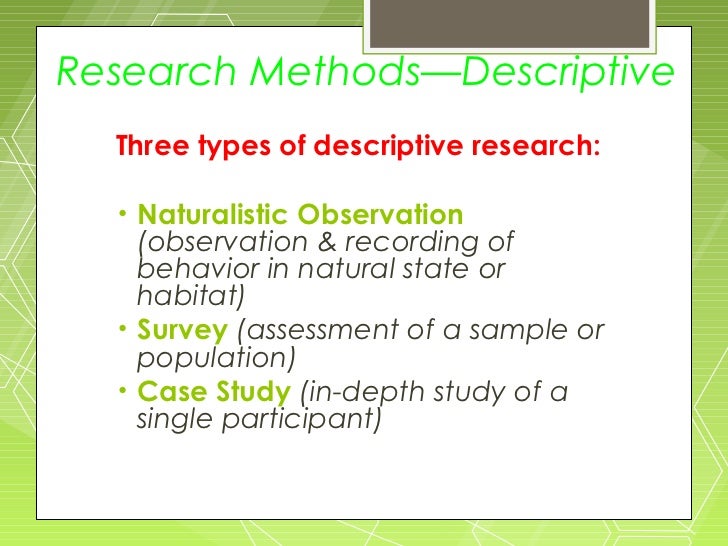Quantitative Research: Descriptive research is quantitative in nature as it attempts to collect information and statistically analyze it. Descriptive research is a powerful research tool that permits a researcher to collect data and describe the demographics of the same with the help of statistical analysis Jan 23, · Correlational research is a type of descriptive research, which is used to measure the relationship between 2 variables, with the researcher having no control over them. It aims to find whether there is; positive correlation (both variables change in the same direction), negative correlation (the variables change in the opposite direction), or zero correlation (there is no relationship between the Estimated Reading Time: 9 mins Nov 28, · What are the three types of descriptive research? The three main types of descriptive studies are case studies, naturalistic observation, and surveys. What are the 5 methodology of quantitative research? Quantitative methodologies include experiments, observation and structured blogger.com Measurements
What are the types of descriptive research design? – blogger.com
The three main types of descriptive studies are case studies, naturalistic observation, and surveys. Quantitative methodologies include experiments, observation and structured interviews…. Making Measurements.
Quantitative researchers generally have four main preoccupations: they want their research to be measurable, to focus on causation, to be generalisable, and to be replicable. Note that your research problem determines the type of design you can use, not the other way around!
The design of a research topic explains the type of research experimental, survey, correlational, semi-experimental, types of descriptive research, review and also its sub-type experimental design, research problem, types of descriptive research, descriptive case-study.
There are three main types of research design: Data collection, measurement, types of descriptive research, and analysis. Like a true experiment, a quasi-experimental design aims to establish a cause-and-effect relationship between an independent and dependent variable.
However, unlike types of descriptive research true experiment, a quasi-experiment does not rely on random assignment, types of descriptive research. Instead, subjects are assigned to groups based on non-random criteria.
Secondary analysis of existing data provides an efficient alternative to collecting data from new groups or the same subjects. Secondary analysis, defined as the reuse of existing data to investigate a different research question Heaton,has a similar purpose whether the data are quantitative or qualitative. Secondary data is information that is obtained by someone other than the primary researcher. Examples include government census reports, other governmental databases, and administrative data.
Researchers are often drawn to the time and cost saving benefits of using secondary data. To conduct meaningful secondary analysis, researchers must spend significant time reading and learning about the origins of the data sets. Through careful reading and vetting, researchers can determine: The purpose for which the material was collected or created. The specific methods used to collect it. Primary data sources include; Surveys, observations, experiments, questionnaires, focus groups, interviews, etc.
Secondary data, on the other hand, do not require interaction with the subject of study before it can be collected. Secondary analysis is the re-analysis of either qualitative or quantitative data already collected in a previous study, by a different researcher normally wishing to address a new research question. Common sources of secondary data for social science include censuses, surveys, organizational records and data collected through qualitative methodologies or qualitative research.
Primary data, by contrast, are collected by the investigator conducting the research. Secondary data are data, which cannot be traced back to the level of individual cases of statistical units. In contrast to primary data it does not allow for mathematical calculations such as determining an arithmetic mean, a correlation, etc. Primary data refers to the first-hand data gathered by the researcher himself. Secondary data means data collected by someone else earlier. Surveys, observations, experiments, questionnaire, personal interview, etc.
Government publications, websites, books, journal articles, internal records etc. Secondary data: It refers to the data collected by someone other than the user i. the data is already available and analysed by someone else. Types of descriptive research sources of secondary data include various published or unpublished data, books, magazines, newspaper, trade journals etc.
You must be logged in to post a comment. Begin typing your search term above and press enter to search, types of descriptive research. Press ESC to cancel. Skip to content Home Philosophy What are the three types of descriptive research?
Ben Davis Types of descriptive research 28, Table of Contents. READ: Is insouciant a word? READ: Are false memories a sign of dementia? READ: Is it hard to get into UC Berkeley engineering? Previous Article Is Muslim an ethnic religion? Next Article How can we evaluate health products?
Leave a Reply Cancel reply You must be logged in to types of descriptive research a comment. Home Lifehacks Admission Essay Coursework Assignment Articles Helpful tips Blog FAQ About Contacts. Search for: Begin typing your search term above and press enter to search. Back To Top.
Types of Research Questions - Exploratory, Descriptive \u0026 Causal Research Question - MIM Learnovate
, time: 6:26
Nov 28, · What are the three types of descriptive research? The three main types of descriptive studies are case studies, naturalistic observation, and surveys. What are the 5 methodology of quantitative research? Quantitative methodologies include experiments, observation and structured blogger.com Measurements Feb 18, · What are the types of descriptive research design? The three main types of descriptive studies are case studies, naturalistic observation, and surveys. What are descriptive study designs? PURPOSE OF DESCRIPTIVE DESIGNS The purpose of descriptive studies is to describe individuals, events, or conditions by studying them as they are in nature Quantitative Research: Descriptive research is quantitative in nature as it attempts to collect information and statistically analyze it. Descriptive research is a powerful research tool that permits a researcher to collect data and describe the demographics of the same with the help of statistical analysis

No comments:
Post a Comment